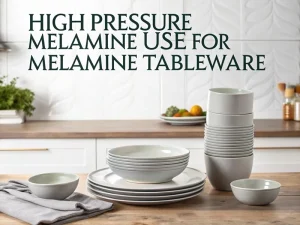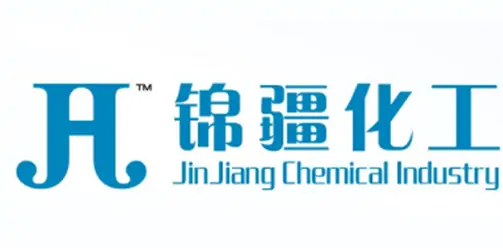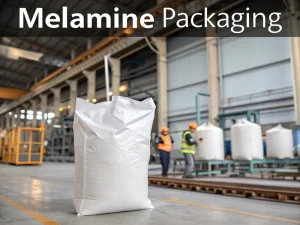
High Pressure Nelamine Use For Melamine Tableware Advantage
Tech Blog High Pressure melamine Use For Melamine Tableware Melamine tableware has become a staple for households, restaurants, and catering services worldwide due to its


Melamine powder is a widely used organic compound, widely used in the production of laminates, coatings, tableware, and adhesives. This article mainly introduces the chemical resistance of melamine, with a focus on its interactions with acids, bases, solvents, and other corrosive substances. This article explores the chemical resistance of melamine, its potential mechanisms, practical applications, and key considerations for industrial use.
The chemical resistance of melamine powder originates from its thermosetting polymer structure, especially in melamine formaldehyde (MF) resin. During the synthesis process, melamine reacts with formaldehyde to form a three-dimensional cross-linked network of covalent bonds.
This structure can prevent the polymer from dissolving in the most common solvents. Try to minimize swelling or degradation when in contact with chemicals.
The triazine ring in melamine enhances further stability. Its aromatic properties and delocalized π electrons enable it to resist electrophilic attacks. At the same time, the connected amino groups (-NH₂) can form hydrogen bonds, enhancing the structural integrity of the polymer.
Weak acids (such as acetic acid, citric acid):
Performance: MF resin is resistant to weak acids (pH ≥ 3) at room temperature.
Example: Melamine tableware is resistant to vinegar (5% acetic acid) and shows no significant degradation after 24 hours.
Strong acids (such as HCl, H₂SO₄):
Limitation: Degradation occurs at pH<2, releasing formaldehyde and hydrolyzing into cyanuric acid.
Weak base (such as NaOH ≤ 5%):
Stability: MF resin can withstand weak alkali (pH ≤ 10) without causing structural damage.
Strong alkali (e.g. NaOH>10%):
Failure: Saponification can damage the methylene bridges in MF resin, causing expansion and delamination, resulting in surface corrosion or discoloration.
Polar solvents (such as ethanol, acetone):
Resistance: MF resin shows negligible expansion (<2%) after soaking for 7 days.
Nonpolar solvents (such as hexane, toluene):
Inert: There is no chemical interaction, but prolonged exposure may cause surface cracking.
Bleach (sodium hypochlorite):
Degradation: Chlorination of amino groups leads to yellowing and brittleness.
Hydrogen peroxide (H₂O₂):
Effect: After 30 days of 3% H₂O₂, the weight of MF resin decreased by 15%.
Although melamine powder is typically resistant to many chemicals, its actual performance may vary due to the following factors:
Curing process: Properly cured melamine resin exhibits better resistance.
Mixture composition: Additives and fillers can affect chemical durability.
Surface smoothness: High-gloss surfaces may be more prone to scratches, but are less likely to absorb chemicals.
Food acidity: Citric acid in fruits, acetic acid in vinegar, and lactic acid in dairy products cause minimal damage.
Stains and dyes: The nonporous surface of melamine resin can resist absorption by coffee, tea, or sauce, making it easy to clean.
Tabletop and floor: MF-based laminated panels can resist the overflow of common household cleaning agents, oils, and dyes.
External coating: In moderate environments, melamine resin can withstand rainwater, humidity, and mild industrial pollutants.
Electrical insulator: Melamine-based components can resist moisture and mild chemicals in electrical systems, ensuring long-term reliability.
Underhood parts: Although not suitable for direct contact with engine oil or coolant, melamine composite materials are used for noncritical applications that require moderate chemical resistance.
The chemical stability of melamine at high temperatures (up to~160°C) makes it suitable as a flame retardant additive in plastics and textiles. Its thermal degradation resistance enables it to release nitrogen and suppress combustion without premature decomposition.
UV exposure: Prolonged exposure to sunlight can cause melamine-based materials to turn yellow or brittle. In contrast, exposure to moisture or acid can accelerate this process.
Biodegradation: Melamine is difficult to degrade by microorganisms, leading to environmental persistence. In landfills or water bodies, it may slowly leach out trace amounts of formaldehyde or melamine itself, posing an ecological risk.
Formaldehyde Release: Melamine formaldehyde resin can degrade and release formaldehyde, a known carcinogen, in high temperatures (e.g., close to 160 ° C) or acidic environments. This is a key issue in food contact applications or poorly ventilated indoor environments.
Toxic by-products: In industrial accidents involving fires or high-temperature processing, melamine can decompose and release cyanide and ammonia, posing a serious threat to the health of workers.
The chemical resistance of melamine is one of its decisive characteristics, which makes it widely used in various industries. By understanding its unique chemical properties, melamine can be effectively used. Although melamine powder is not impermeable to all substances, especially strong acids or prolonged exposure to chemicals, it is still the preferred choice for durable, low-maintenance surfaces.

Tech Blog High Pressure melamine Use For Melamine Tableware Melamine tableware has become a staple for households, restaurants, and catering services worldwide due to its

Tech Blog Melamine packaging For manufacturers, inaccurate packaging not only fails to meet national standards but also increases labor costs and the risk of product

Tech Blog How to Detect Melamine in Textiles? Melamine powder, a nitrogen-containing heterocyclic compound, is widely used in flame-retardant textiles and plastic products due to

JINGJIANG MELAMINE POWDER
© JINJIANG MELAMINE